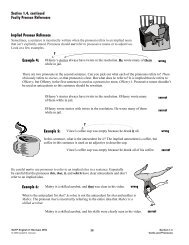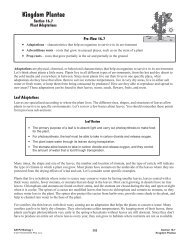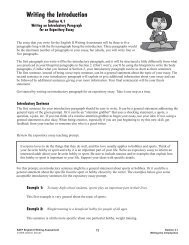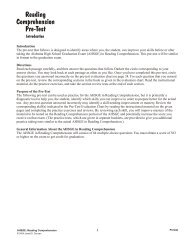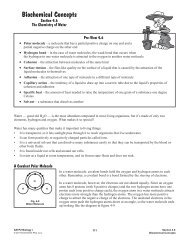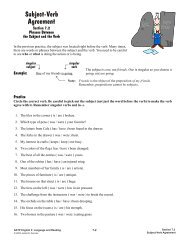Mississippi SATP2 Algebra I Student Review Guide - Enrichment Plus
Mississippi SATP2 Algebra I Student Review Guide - Enrichment Plus
Mississippi SATP2 Algebra I Student Review Guide - Enrichment Plus
You also want an ePaper? Increase the reach of your titles
YUMPU automatically turns print PDFs into web optimized ePapers that Google loves.
Non-linear Functions<br />
Section 26.2<br />
Quadratic Equations From<br />
Graph and Tables<br />
Now that you know how to find the information about quadratic functions from a<br />
graph or a table, let’s see what you can do with it.<br />
Let’s say you have a graph or a table and need to match it to its equation. To match a graph<br />
or table to a quadratic equation, you need to check at least three points. You could take each<br />
set of integer coordinates from the graph or table, substitute them for x and y values in the quadratic equation, and<br />
then simplify. If the two sides are equal for each set of points, the graph or table matches the equation. The easiest<br />
points to pick, if they are integers, are the two x-intercepts and the y-intercept, but any three points will do.<br />
Substituting three different points into an equation to see if the equation is true<br />
can be time consuming. It would really be helpful to get an equation from<br />
looking at a graph or a table. You can do just that if you memorize the vertex<br />
form of a quadratic equation as given on the right. It’s called the “vertex” form<br />
because it uses the values for the vertex, h and k. As long as you can identify the<br />
vertex from a graph or a table and have one additional point, you can use this<br />
formula to find the equation of the quadratic.<br />
“Vertex” Formula for a<br />
Quadratic Equation<br />
2<br />
y = a(x – h) + k<br />
Quadratic Equations From Graphs<br />
Let’s start with a graph. Find the equation for the quadratic function graphed below.<br />
–8 –6 –4 –2<br />
–2<br />
–4<br />
–6<br />
–8<br />
8<br />
6<br />
4<br />
2<br />
0 2 4 6 8<br />
This is a three step process:<br />
First, you will need to find the coordinates of the vertex and one other<br />
coordinate from the graph. The y-intercept is a good one to use. Label the x-<br />
coordinate of the vertex as h and the y-coordinate k — you’ll see why in a<br />
minute. Also, label the coordinates of the other point as x and y.<br />
h k x y<br />
vertex = (–1, –4) y-intecept = (0, –3)<br />
Next, you’ll need the “vertex” form of a quadratic equation. It may look weird, but it’s<br />
the quadratic function written in terms of the x and y values of the vertex (h, k).<br />
Substitute the values you labeled into the equation and solve for a. Now, you know<br />
2<br />
two things about your equation: the coefficient of the x term is 1 and the constant term<br />
is –3. How do you get the rest of the quadratic? Glad you asked.<br />
2<br />
y = a(x – h) + k<br />
2<br />
–3 = a(0 – (–1)) + (–4)<br />
2<br />
–3 = a(1) – 4<br />
–3 = a – 4<br />
1 = a<br />
2<br />
y = a (x – h) + k<br />
y = 1(x – (–1))<br />
2 – 4<br />
y = (x + 1)<br />
2 – 4<br />
y = (x + 1)(x + 1) – 4<br />
2<br />
y = x + 2x + 1 – 4<br />
Finally, take the “vertex” form of the equation and substitute the values of a, h,<br />
and k. Simplify and you have the quadratic function that matches the graph.<br />
That wasn’t so bad, was it? It would be well worth your time to memorize this<br />
“vertex” formula. You’ll find it very useful if you need to match a graph to a<br />
quadratic equation.<br />
2<br />
y = x + 2 x – 3<br />
<strong>SATP2</strong> <strong>Algebra</strong> 417<br />
Section 26.2<br />
© 2010 <strong>Enrichment</strong> <strong>Plus</strong>, LLC<br />
Non-linear Functions








